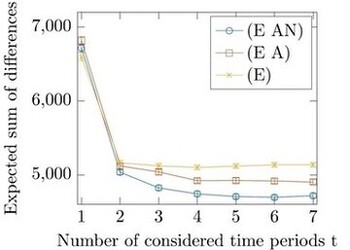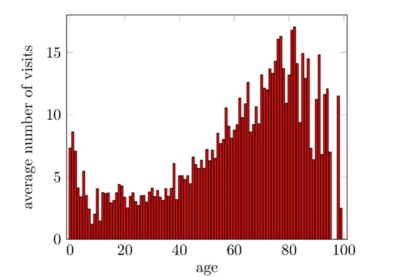Projects
Through direct and funded projects, the Health Care Lab enables the transfer of current research into practice. The application of quantitative methods such as simulation and mathematical optimization supports decision-makers in the healthcare sector in solving concrete problems.
EVRALOG-BW
|
Project duration: 06/01/2021 – 05/31/2023 Project partner: Department for quality assurance of emergency medical services in Baden-Wuerttemberg (SQR-BW) Funding: Interior ministry of the federal state Baden-Wuerttemberg Contact person at the Health Care Lab: Sven Watzinger (sven.watzinger∂kit.edu)
In the case of out-of-hospital illnesses and injuries, citizens in Baden-Wuerttemberg can rely on a functioning emergency medical service (EMS). For several years, the EMS has been confronted with growing challenges such as an increasing number of calls and the centralization of hospitals. In order to master these challenges, Baden-Wuerttemberg, as a pioneer throughout Germany, decided in 2011 to establish the department for quality assurance of emergency medical services in Baden-Wuerttemberg (SQR-BW). The SQR-BW collects operational data from all 35 EMS regions in Baden-Wuerttemberg for data-driven quality assurance. This work will be further expanded through the joint research project EVRALOG-BW. The aim is to develop and investigate new planning criteria for the standardized planning of EMS structures throughout the state. This includes questions such as the positioning of rescue stations or the number of required rescue vehicles. To validate the findings, a simulation is to be used that allows an assessment of the effects of new planning approaches before they are implemented in the real system. For the parameterization of the simulation, the data collected by SQR-BW can be used. The project is co-financed by a grant from the state, which is expected to amount to about 220,000 euros over a period of two years (press release). |
SCATTER
|
Project duration: 01/01/2021 – 12/31/2022 Project partner: Institute for rescue and emergency medicine at the university hospital Schleswig-Holstein Funding: Federal ministry of health Contact person at the Health Care Lab: David Olave (david.olave∂kit.edu), Sven Watzinger (sven.watzinger∂kit.edu)
The panel of experts for Intensive Care, Infectious Diseases, and Emergency Medicine (COVRIIN) supports and advises the Robert Koch Institute on overarching issues in managing COVID-19 cases. The panel's work also includes support for nationwide COVID-19 patient transports in the case of regional hospital overload situations. The project SCATTER, which is funded by the Federal Ministry of Health, aims to develop a computer-based simulation to provide recommendations and decision-making support for such transports. The Health Care Lab is developing the simulation in cooperation with the Institute for Rescue and Emergency Medicine (IRUN) of the University Hospital Schleswig-Holstein (Link). In the first step, a so-called concept model is created through workshops and exchanges with process experts. The concept model describes in graphic or textual form the elements and processes that are to be modeled in the simulation. This is concretized by comparing historical transport data and the continued exchange with process experts and transferred into a parameterisable, computer-based simulation model. The available historical transport data will be analyzed, processed, and transformed into a form suitable for the simulation model to be able to represent the behavior of the actual system. After verification and validation of the simulation, for example, by comparing simulation results with the historical data, different transport strategies can be investigated experimentally with the simulation. The analysis of the simulation results allows an estimation of the expected effects of the transport strategies. System limits and performance potentials are further investigated through scenario-based analyses. In particular, the cross-border performance potential for transports from other European countries can be addressed. Finally, by implementing adaptive decision systems in the simulation, a coupling of strategies and system load can be modeled.
|
Research project: Tactical Demand and Capacity Management for Medical Practices
|
Contact person at the Health Care Lab: Anne Zander (anne.zander∂kit.edu)
This research project is about matching supply and demand of medical services on a tactical planning level. Especially medical practices with panels are considered. In these practices, a large portion of patients is visiting the practice regularly. Two models are explained in detail below. |
||||
|
(1) Control of the indirect waiting times:
In this model, the focus is on the indirect waiting time (waiting time for an appointment). A queuing model is proposed, which determines the distribution of indirect waiting times based on the appointment demand and the physician's working hours. The model is quite flexible and allows, among other things, parameters dependent on the current indirect waiting time, appointment rescheduling, and different arrival and service time distributions.
For example, medical practices can determine how large their panel should be or how many hours they should work per day based on the indirect waiting time service level.
Preliminary results can be found here: Link |
||||
|
Expected indirect waiting time in days, dependent on the panel size and the daily appointment offerings for a queue-length-dependent appointment demand rate and different rescheduling probabilities of no-shows. |
||||
|
(2) Physician Panel Management:
This model focuses on the proactive matching of demand volume and appointment supply in predefined periods. Based on historical data, the model determines how the appointment demand behavior of patients with specific characteristics (e.g. age, gender) changes over time. This knowledge is then used in an integer linear program to decide on the admission of new patients to the physician panel. The goal is to minimize the deviation between demand volume and appointment supply in the considered periods. Best results are obtained with proactive planning (consideration of several future periods) combined with a detailed classification of new patients.
Results can be found here: Link |
||||
|
Expected sum of deviations between the appointment demand volume and the appointment supply over ten years, given the number of years that are considered in the proactive optimization and the different classification grades of new patients with increasing classification accuracy from (E) over (E A) to (E A N). |
Average number of practice visits depending on the patients' age, based on historical data of a family practice. |
|||






